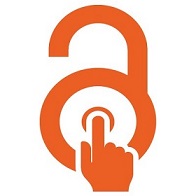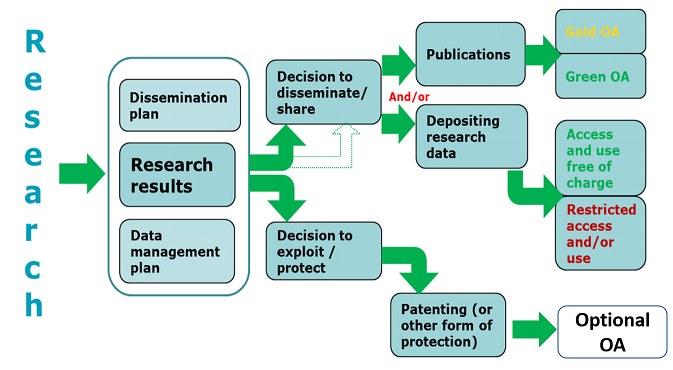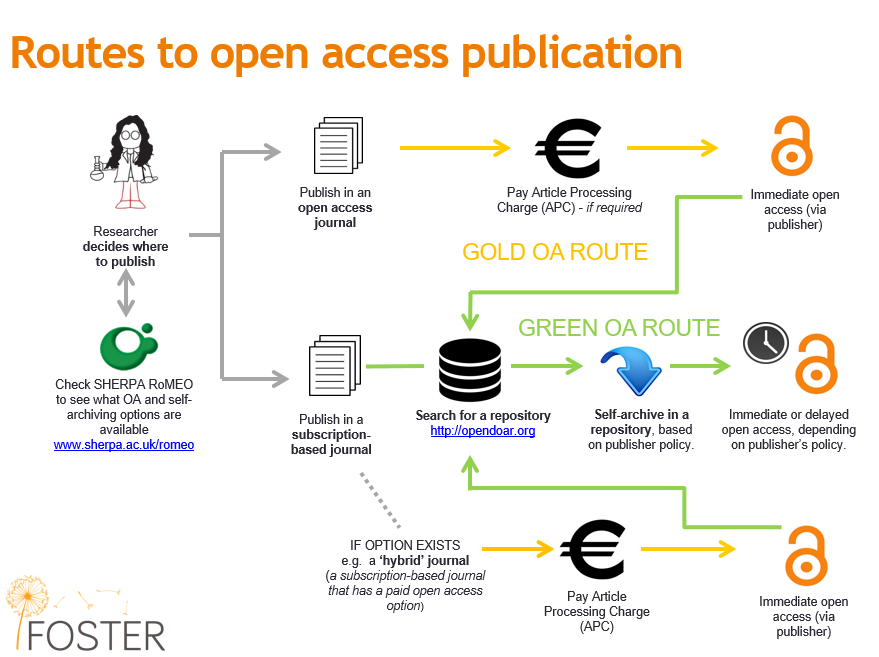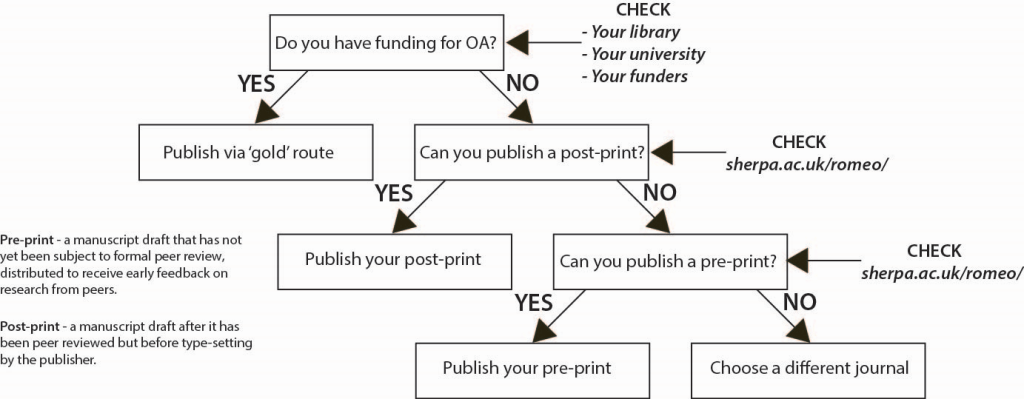
Brief History
The history of OA is a combination of small advances after the launching of several parallel initiatives who brought up the needed benefits of the practice of OA, the technological advancements that greatly improved the possibility for sharing and accessibility, and the financial investment in infrastructures that allow the implementation of OA.
Know more about:
The idea that scientific knowledge should be shared, especially when produced with public funds and that the access to this information is essential for the advancement of science itself (like the Declaration on science and the use of scientific knowledge, 1999 by UNESCO), pave the way to create the context needed to approach what was later know as Open Access.
“Open Access” (OA) was firstly mentioned in 2002, in the scope of the Budapest Open Access Initiative (the BOAI 2002, reaffirmed through the Bethesda Statement on Open Access Publishing and the Berlin Declaration on Open Access to Knowledge in the Sciences and Humanities, in 2003).
The BOAI 2002 not only launched a worldwide campaign for OA to all new peer-reviewed research, but also proposed complementary strategies for realizing the OA:
- Self archiving: authors deposit their article in a repository/open electronic archives which can be accessible through OA search engines. This strategy lead to what is known by Green Access.
- Open Access journals: authors publish their work in OA journals, that will use copyright and other tools to ensure permanent open access to articles. This strategy lead to what is known by Gold Access.
Many other declarations and initiatives on OA, mainly promoted by researchers, were launched ever since. The Open Access Directory provides an extensive list of declarations in support of OA since 1964.
Several efforts have been taken towards the implementation of Open Access in Europe. One of the major promotion driving forces to make Open Access in Europe a reality is the European Commission who has been gradually incorporating OA practices in its policies and regulations:
2006 – “Scientific Publication – Policy on open access” European Research Advisory Board (EURAB)
2007 – “FP7 Model Grant Agreement" (Part C; Section I – II.30 Dissemination). Each beneficiary was expected to ensure the dissemination of foreground as swiftly as possible. The dissemination of results produced in FP7 funded projects was promoted but was not yet mandatory.
2012 – “Recommendation on access to and preservation of scientific information [COM(2012) 4890],” stating that “open access to publications and data from publicly funded research should be promoted and access to publications made the general principle for projects funded by the EU research Framework Programmes”. Two reports on the implementation of Commission Recommendation COM(2012) 4890 were followed (2016’s version and 2018’s version).
2013 – “Rules for participation and dissemination in H2020 [ Regulation (EU) No 1290/2013]” considered to cover the costs related to scientific publications and data resulting from their funded research, to promote and assure the practice of OA: “Costs relating to open access to scientific publications that result from research funded under Horizon 2020, incurred within the duration of an action, shall be eligible for reimbursement under the conditions of the grant agreement. (…)”.
2014 – “ H2020 General Model Grant Agreement“ (the law binding contract between the EC and H2020 project Coordinators) includes Article 29 - Dissemination of results — Open Access — Visibility of EU Funding, establishing the obligation to disseminate results (when there is no plan for later exploitation of results), to provide open access to scientific publications and related research data (each beneficiary must ensure open access, free of charge, online access for any user, to all peer-reviewed scientific publications relating to its results) within six months of publication, at the latest (or twelve months for publications in the social sciences and humanities).
2016 – First version of “Guidelines on Open Access to Scientific Publications and Research Data in Horizon 2020”. This document has received several updates ever since.
2016 - The 3 O’s policy: Open Innovation, Open Science, Open to the World – a vision for Europe
2018 - Implementation Roadmap for the European Open Science Cloud. The EOSC is being implemented by H2020 funded projects: EOSCPilot, EOSC-Hub, OpenAIRE-Advance, Freya, eInfraCentral, RDA Europe 4.0, GEANT, HNSciCloud and there is more H2020 funding reserved throughout 2020 for more actions related to the architecture, FAIR data, Services, Governance and rules of participation of the EOSC.
2018 – the European Commission “Proposal for a REGULATION OF THE EUROPEAN PARLIAMENT AND OF THE COUNCIL establishing Horizon Europe – the Framework Programme for Research and Innovation, laying down its rules for participation and dissemination [COM(2018) 435]”, suggest an Open Access policy that goes beyond the one in H2020, requiring open access to publications and data (with robust opt-outs for the latter), and to research data management plans (Art. 10º and 35º). The Programme will foster the widespread use of FAIR (findable, accessible, interoperable, and re-usable) data; and activities that enhance researchers’ skills in open science and support reward systems that promote open science.
The benefits of the practice of OA are several and its impacts reach a vast group of the society:

Do you want to practice Open Access?
“Open Access”, refers to the practice of providing online access to scientific information that is findable, interoperable, free of charge to the end-user, and reusable. 'Scientific' refers to all academic disciplines. In the context of research and innovation, 'scientific information' can mean:
- peer-reviewed scientific research articles (published in scholarly journals) or
- research data (data underlying publications, curated data and/or raw data).
One of the advantages of OA is to broaden the access to scientific articles and data. The access to a wider range of scientific accessible information supports researchers to better plan their work and manage resources, efforts and eventual scientific outcomes. OA can contribute in several ways and in several steps of a researcher’s discovery cycle, either in the preparation phase of the experiments as well as during results’ analysis and finally research dissemination to promote a wider scientific discussion of the new findings or research exploitation to allow the application of the scientific outcomes.
Experience the benefits of Open Access by:
- Accessing previously released information and data.
- Planning your work using a Data Management Plan.
- Providing Open Access to your work and increase your visibility.
There are many resources that supports the relevant stakeholders to get open access to scientific publications and data. Just to mention a few multidisciplinary ones:
- DOAB – Directory of Open Access Books
- DOAJ - Directory of Open Access Journals
- GOAP - Global Open Access Platform (run by UNESCO)
- OAD – Open Access Directory
- OpenAIR – the EU repository linked to the Participant Portal (for H2020 projects reporting)
- OpenDOAR - The Directory of Open Access Repositories
- PLOS – Public Library of Science
- ZENODO – an EU open access repository
Depending on the Open Access (OA) policy linked to a funding program or institutional procedures, it does not mean that the author has to provide full OA to all his project outcomes. Some results might be planned to be reserved for later exploitation or not be openly disseminated for another well justified reason. All these and other aspects of data management, are defined in the Data Management Plan (DMP) that are requested at the level of funding applications to calls. The DMP describes the data management life cycle for all datasets to be collected, processed or generated by a research project. It covers several aspects related to handling of research data, methodologies and standards, plans for whether data will be shared /made open access and how and how data will be curated and preserved.
Open Access Resources - Data Management Guidelines & Tools
Following the DMP and according to the achievements and outcomes of the project, the results (scientific publications and data) can be planned to share/disseminate and made available in OA (most of OA mandatory funding programs covers the OA charges) or temporarily kept for later results’ exploitation/protection and/or dissemination at a later stage or results’ exploitation.
Open access to scientific publication and research data in the wider context of dissemination and exploitation

An important supporting resource to consider regarding IPR issues is the IPR Helpdesk.
The type of open access, the specific repositories, the timing and the procedures to practice open access should be established in OA mandates, that can be adopted by a research institution, a research funder or a government.
There are 2 main routes to provide OA:
- Self-archiving / “green” open access – the author, or a representative, archives (deposits) the published article or the final peer-reviewed manuscript in an online institutional or subject specific repository before, at the same time as, or after publication. In this case, they must ensure open access to the publication (the embargo period) within six months of publication (12 months for social sciences and humanities). An alternative to national and institutional repositories is ZENODO (the EU’s open repository). In this model, the copyright is retained by the publisher.
- Open access publishing / “gold” open access - an article is immediately published in open access mode and accessible to all readers, in OA or hybrid journals (subscription based journal with a paid open access option). The payment of publication costs is shifted away from subscribing readers. The most common business model is based on one-off payments by authors. These costs, often referred to as Article Processing Charges (APCs) are usually borne by the researcher's university or research institute or the agency funding the research. In other cases, the costs of open access publishing are covered by subsidies or other funding models. In this model, the copyright is held by the author.
Open Access Publishing models, depending on the conditions to cover the APCs

The decision on the OA model should be supported by preliminary information on OA Repository Mandates and policies as well as copyright policies followed by different publishers. This information could be found in different platforms:
- ROARMAP - Registry of Open Access Repository Mandates and Policies. ROARMAP is a searchable international registry charting the growth of open access mandates and policies adopted by universities, research institutions and research funders. Such policies request or require that researchers provide open access to their peer-reviewed research article by depositing it in an open access repository.
- SHERPA/JULIET - listing research funders’ open access policies. JULIET is a searchable database that provides quick summaries of funding agencies´ grant conditions regarding self-archiving of research publications and data. It also provides statistics on open access journals and policies.
- SHERPA/ROMEO - RoMEO provides a searchable database of publishers´ copyright and self-archiving policies for preprints and postprints. It is aimed at users already familiar with open access and shows which publishers comply with funding agencies´ conditions on open access.
How to make your research Open Access?

(source: Fossilsandshit)
... and there is always the option to use ZENODO – the EU open access repository.
Find the available resources on Open Access
Find the available resources on Open Access

